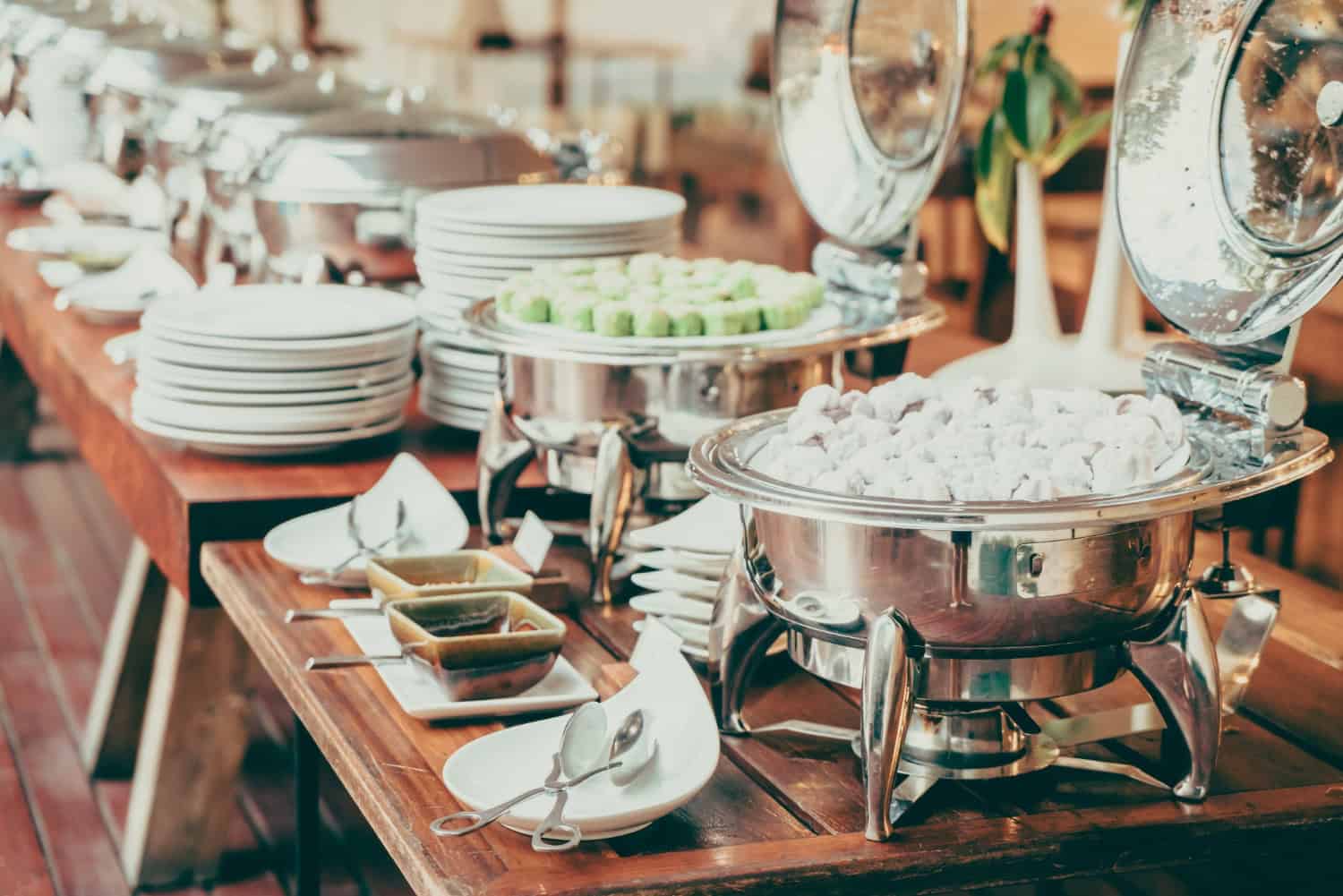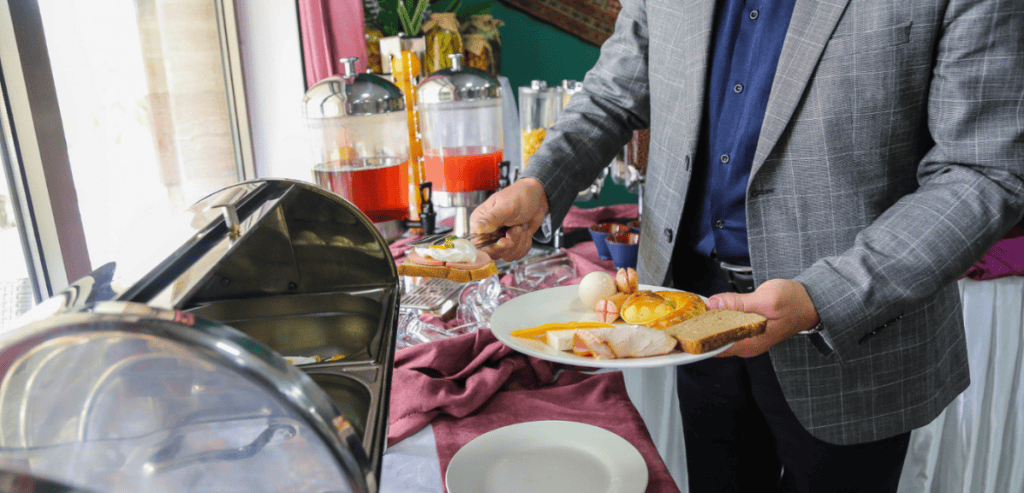
By Jermaine Thomas July 23, 2025
Choosing the right catering style can make or break your event, both in terms of guest satisfaction and budget. Whether you’re planning a wedding, corporate luncheon or milestone celebration, the decision between buffet and plated service affects not just the flow of the event but also the budget and overall vibe.
Buffet service is often associated with casual, flexibility, variety and self-serve ease. Plated dinners are formal, ordered and personal attention. Both can create great dining experiences but how do they stack up when you compare cost and quality?
Buffet Service
Buffet catering is a popular choice for many event types, offering a relaxed and interactive dining experience. Guests serve themselves from a spread of dishes, usually by cuisine or course. This format allows everyone to eat at their own pace and choose what they like in the amount they like.
Flexibility in Menu and Portion Size
One of the biggest advantages of buffet service is the flexibility it offers. Unlike plated meals where each guest gets a set portion, buffets let people eat more or less and try different combinations. This is especially useful for diverse groups where dietary preferences vary widely.
Buffets also reduce food waste when managed properly. Guests can take what they want and servers can replenish popular items. This system also makes it easier to accommodate vegetarians, gluten-free eaters and those with specific dietary restrictions without having to create separate dishes.
Staffing and Setup Considerations
Buffet catering typically requires fewer serving staff. Since guests serve themselves, fewer waiters are needed to plate and deliver food. Staff primarily focus on keeping the buffet line clean, restocked, and organized. This reduction in labor often translates into significant buffet catering savings compared to plated meals.
However, the space requirement is larger. You need sufficient room for food tables, warming trays, and guest flow. In tight venues, this can pose a logistical challenge. Presentation is another factor. Buffets must be visually appealing while remaining functional, which means extra planning around layout and décor.
The Plated Dinner Experience
Plated dinners are a traditional and refined catering format. Guests remain seated while servers bring individual courses to the table. This style is commonly used in formal events, charity galas, and weddings that prioritize elegance and structure.
Predictability and Precision
With plated dinners, every guest receives the same portion of the chosen entree, sides, and dessert. This predictability offers several advantages. The kitchen staff knows exactly how many plates to prepare, which leads to more accurate food costing and less guesswork.
From a presentation standpoint, plated meals allow for more visually stunning dishes. Chefs can control plating and portion aesthetics, which adds a touch of sophistication. For hosts who value precision and personalization, plated meals provide a polished experience that feels curated.
Higher Staffing Requirements
Compared to buffets, plated dinners involve more labor. You need waitstaff to deliver meals, clear courses, refill drinks, and coordinate service timing. This increases the cost of labor, often making plated dinners more expensive even if the food cost is similar.
Additionally, plated meals require clear meal selections in advance. Guests usually RSVP with their meal preference weeks before the event. This requires a robust planning process and excellent communication between the host, caterer, and attendees.

Buffet Catering Savings: Where You Can Cut Costs
Many event planners lean toward buffets not just for their versatility but for the potential cost savings. Buffet catering savings come from several areas, especially in labor, food preparation, and reduced waste.
Labor Efficiency
Because fewer staff members are needed to execute a buffet, labor costs decrease. A single server can manage multiple buffet tables, and there’s less need for individually plated meals or table service. Over the course of a large event, this adds up to meaningful savings.
In addition, buffets are often easier to set up and break down. With a streamlined format, you can reduce venue rental time, cleaning hours, and overall operational costs.
Ingredient Control
Buffets allow you to offer a variety of dishes using fewer total ingredients. For instance, a single protein can be presented in two or three styles or paired with various sides to create perceived variety. This approach enables caterers to work creatively with the same core ingredients and control cost. In many cases, caterers prepare slightly more food for buffets to avoid running out, but this overage often costs less than the structured portions required for plated dinners.
Plated Dinner Cost Comparison: Where the Budget Rises
Plated dinners look uniform and beautiful but the cost to deliver that level of service and detail is higher. When doing a plated dinner cost comparison you have to account for more than the menu.
Staffing and Timing
Each guest has to be served within a short window of time to keep meal temperature and consistency. That means more servers, runners and sometimes chefs dedicated to plating each course in sequence. More hands means more labor charges.
And the flow of the event becomes tied to the meal service. Timing speeches, toasts and entertainment around a plated dinner requires precise coordination which may also mean hiring an event coordinator or adding hours to staff schedules.
Menu Complexity
To keep things smooth, plated dinners usually require final headcounts and meal choices in advance. Special requests can complicate things and require custom preparation. Managing these details means extra prep time and higher food costs.
And plated meals require more expensive presentation and packaging supplies. From multi-piece place settings to glassware the visual standard of a plated meal can add to rental and service costs.
Guest Experience: Atmosphere and Interaction
While budgeting is important, the guest experience should never be overlooked. The serving style you choose influences how guests feel during the event.
Social Dynamics of Buffets
Buffets are informal and promote movement and interaction. Guests mingle in line, talk about food, and explore different dishes together. This dynamic can contribute to a lively, social atmosphere that works well for family events and corporate mixers. The trade-off is potential wait times and uneven pacing. Some guests may finish eating while others are still in line. This can affect speeches, entertainment, and overall flow.
Elegance and Order of Plated Meals
Plated meals create a sense of formality and care. Everyone is served at the same time, which helps keep the event on schedule. Seated service also reduces foot traffic, making the environment feel calmer and more refined.
For guests who appreciate comfort and polish, plated meals offer a high-end experience. There’s also a sense of being taken care of, which is especially appreciated at milestone events like weddings or retirement dinners.

Affordable Catering Styles: Blended Approaches
Some events do not need to strictly follow one style or the other. By blending elements of buffet and plated service, hosts can create affordable catering styles that deliver both savings and impact.
Buffet with Plated Starters or Desserts
One common approach is to offer a plated starter or dessert while keeping the main course as a buffet. This controls some portion sizes while still allowing variety and guest interaction. It also cuts down on overall labor compared to full-service dining.
Station-Style Service
Food stations offer a middle ground between buffet and plated. Instead of one long line, guests visit themed stations where chefs prepare small plates or serve specialty items. This keeps lines short and allows for menu creativity without the full cost of plated service. Stations can be especially useful for smaller events where variety and presentation are still priorities.
Family Style Dining
Another alternative is family-style service, where large platters are brought to each table for guests to share. This combines the portion control of plated meals with the communal feel of a buffet, often at a lower cost than full-service. It also fosters conversation and works well in events aiming for a warm, inclusive atmosphere.
Practical Considerations Before Choosing
Before deciding between buffet or plated service, consider the details of your event. The right style depends not only on budget but also on venue size, guest demographics, and event timing.
Guest Count and Venue Layout
Buffets require space for food tables and guest movement. In a cramped room, this may cause discomfort. Plated meals, while seated, need space for extra staff and plate service flow. Consider your layout carefully before making a final call.
Type of Event
For formal galas or black-tie weddings, a plated dinner may feel more appropriate. For birthday parties, holiday gatherings, or team celebrations, a buffet might feel more relaxed and enjoyable. Think about your audience and what kind of experience they expect.
Food Preferences and Dietary Needs
If your guest list includes a wide range of dietary preferences, a buffet offers more freedom. Guests can select exactly what they want, avoiding awkward substitutions. For events with limited dietary variation, plated meals can offer elegance with controlled execution.
Final Thoughts
Buffet and plated services each have pros and cons, depending on budget, goals, and event style. Buffets offer cost and labor efficiency, ideal for casual or large gatherings. Plated dinners provide elegance and structure. Thoughtful planning and guest-focused decisions ensure a satisfying, cost-effective dining experience with either option.